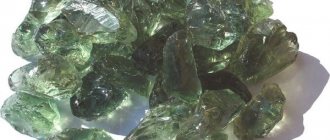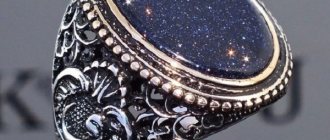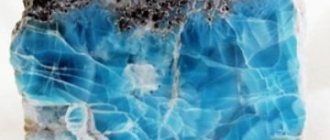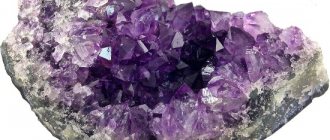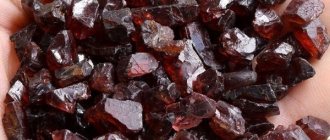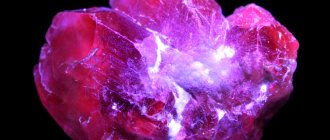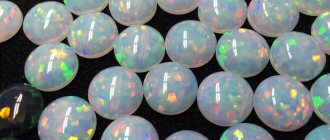Story
It is believed that the Greeks were the first to discover prasiolite. This happened more than 2500 years ago . The discoverers noticed that the intensity of the green color of the crystals depends on the sun: the brighter it shines, the paler the stone. The Greeks believed that it was the gods who painted the crystals, giving them magical properties.
In historical sources dating back to the ninth century BC, this stone is mentioned under the name prasitis. Later it was changed to prasiolite, translated from Greek as “leek-colored stone.” It is sometimes called "onion stone."
This mineral of a pleasant light green color is also known under other names:
- vermarine;
- peridine;
- green chrysoquartz;
- emerald or green quartz;
- Indian emerald.
Prasem - This term is applied not only to prasiolite, but also to any quartz that has an onion-green or grassy color.
Many centuries ago it was noticed that yellow and purple quartz could turn green when heated, like true prasiolite. Residents of the Urals baked yellow citrine into loaves of bread for this purpose.
Varieties of prasiolite
Artificially created prasiolite is distinguished by a wide variety of shades. The color range of the synthesized gem depends on the color of the original stones (citrine and amethyst are heated to 5000 °C, then irradiated with ultraviolet light).
But even in natural minerals the number of shades is quite large .
The rarest and most unique are lemon-colored stones. It is a collector's item and an incredible value.
Crystals of onion-green and green with a yellowish tint are very popular .
The most common options:
- emerald;
- dark green.
Green amethyst or prasiolite: how to distinguish these stones from each other
There is still confusion in gemology regarding prasiolite: some experts consider it a green amethyst, others believe that it is simply a green variety of quartz.
The quartz group also includes amethyst, famous for its purple color.
The name “green amethyst” appeared in 1950 at the Montezuma mine in the Brazilian state of Minas Gerais. There, an artificial analogue of prasiolite was obtained by calcining amethyst at a temperature of 500 °C . The artificial stone turned out to be transparent and more durable than natural stone. Its color can be different shades of green.
The reason for this experiment was the following:
- Demand for green stones;
- Weak resistance of prasiolite to sunlight. When removed from the bowels of the Earth, it becomes discolored and becomes ordinary (colorless) quartz.
- Limited availability of natural prasiolite deposits.
- Relatively cheap material for producing artificial stone.
To create artificial prasiolite, the method of ionized irradiation is also used (it is used mainly in Africa).
There is another method: the stone is heated, then dipped into a cold dye solution. Thermal shock causes microcracks to appear in the mineral, into which pigment penetrates.
Color characteristics of natural and artificial prasiolite:
- The shades of the natural mineral are light green.
- The rich dark green color is characteristic mainly of stone processed at high temperatures.
To determine the naturalness of prasiolite, it is better to have it examined by a mineralogist who has the appropriate equipment.
In 1950, it was decided to consider prasiolite to be a type of quartz, and not to make a difference between natural and artificial stones.
Proponents of complete naturalness do not like this decision, but stone breeders accepted it with pleasure and began to reap the benefits of this compromise.
Description and origin of the stone
Prasiolite is a type of quartz. The stone is fragile, so it is extremely difficult to process it. The color ranges from shades of green. This material is often confused with stones such as:
- peridot;
- prase;
- tourmaline.
Sometimes the mineral is called “green quartz”, “vermarine” or “onion amethyst”. Most of the representatives that are sold on the jewelry market are obtained in laboratory conditions. Similar stones are created from amethyst by heating. Whether such samples are natural is a controversial issue.
Helpful information
Despite their origin, they have the physical and chemical properties of true prasiolite. However, it is generally accepted that such minerals do not possess magical energy.
Physicochemical characteristics
Prasiolite is a rare variety of quartz. It has a range of green colors, rich in shades: from pale gray-green to grassy.
Sunlight can fade the color of the stone.
- Chemical formula - SiO2 .
- Color - onion green.
- The shine is glassy, pearlescent.
- Transparency - transparent or semi-transparent.
- Hardness - 7.
- Density - 2.65 g / cm3 .
The shape of the crystals is a hexagonal prism. The stone is quite fragile. Outwardly it resembles tourmaline, beryl, and peridot.
Deposits and physical properties
The formula of prasiolite is SiO2, like other types of stones belonging to the quartz family. It does not have luminescence or pleochromism, that is, it does not change shade if you look at the mineral from a different angle. The mineral is transparent or translucent, with a hardness of 7 out of 10 on the Mohs scale. It is dense, but quite fragile. These properties make it similar to peridot or beryl.
Green prasiolite is a fairly rare stone. There are only a few places on the planet where it is mined in industrial quantities:
- India. Specimens of a luxurious green hue are often found here, mesmerizing with the play of halftones.
- Brazil. Onion stones mined in this country are distinguished by their restrained, austere light color.
- USA. American specimens are the largest.
- Gems from the Primorsky Territory of the Russian Federation can boast of the correct shape and richness of colors, not inferior to Indian ones.
If you believe jewelers, it is quite difficult to find an authentic natural gem on the shelves. Crystal deposits are not very rich, and a method for producing artificial stones has long been developed. To do this, amethyst or citrine is heated to a temperature of 5,000 degrees, after which it is irradiated with ultraviolet light. Unfortunately, prasiolites obtained in the laboratory do not have magical or therapeutic properties.
Place of Birth
Prasiolite is rare in nature. Findings have been reported in:
- Canada;
- Brazil;
- USA;
- Namibia;
- Tanzania;
- Zambia;
- Poland.
Today, supplies are largely depleted, so most of the prasiolite on the market are artificial stones. Since 1950, they have been produced by heating amethyst and yellowish varieties of quartz from Brazil (Montezuma deposit) and the USA (Arizona) by at 500 °C
Prasiolite
Prasiolite is an incredibly beautiful transparent quartz of a calm green color. Shades can range from rich herbaceous to minty. This stone is also called green amethyst.
Prasiolite will definitely catch your eye among the variegated gems on display: this stone will attract you with its soft color and transparency.
Physical properties of prasiolite.
- Formula
: SiO2.
- singonia
: trigonal.
- Hardness
(Mohs scale): 7. (On a scale from 0 to 10, where 10 is the hardest stone, diamond).
- Density
: 2.6 g/cm3.
Green amethyst is practically never found in nature; it is obtained by calcining amethysts and citrines. Since the 1950s, they began to obtain this beautiful stone by heating amethyst to 500 degrees Celsius.
History of prasiolite.
Prasiolite got its name from the word “prasio”
- “onion”, thanks to its delicate green color. Mentions of this stone were found back in Ancient Greece.
In the Middle Ages, prasiolite was considered capable of endowing its owner with insight and wisdom.
.
In the 18th century, the Polish king presented Catherine II with a luxurious brooch
with prasiolite. They say that the empress loved the decoration so much that she did not part with it until her death.
Prasiolite deposits.
Prasiolite today is heat-treated gems from Brazil
(Montezuma deposit). Also, similar crystals are found in the US state of Arizona.
How to care for prasiolite jewelry.
Like all quartz, prasiolite is extremely sensitive to sunlight. It will fade over time, so keep it in a closed box and don't wear it in the sun for a long time. Refrain from wearing jewelry with this stone on the beach and on hot summer days.
Wipe prasiolite regularly with a soft flannel cloth, as it easily becomes covered with a greasy coating and loses its shine and transparency. You can wash it in warm water and soap.
The magical properties of prasiolite.
Prasiolite is traditionally considered a talisman of love
.
Jewelry with this stone will fill you with energy, a feeling of lightness and freedom.
This stone promotes eloquence and imagination
.
Also, the stone attracts harmony, financial well-being, success, good luck, and love into life.
A green gem will become a talisman against negativity, protect against the evil eye, damage and evil. It should be framed in silver.
Medicinal properties of prasiolite.
Prasiolite has a surprisingly calming and harmonizing
impact on the body.
It helps cope with insomnia
, improve
sleep, and overcome stress
.
In addition, it is believed that prasiolite facilitates the progression of ARVI and strengthens memory.
If you suffer from tachycardia, wear a ring with this stone on the ring finger of your left hand. This will help relieve attacks.
Prasiolite has a general rejuvenating effect
on the body and skin. If you hold a pebble in water and then wash your face with it, it will refresh your face and smooth out wrinkles.
Who does prasiolite suit according to their zodiac sign?
Prasiolite is a non-conflict stone; it goes well with almost all signs of the Zodiac. It will become a particularly strong amulet for Pisces, Sagittarius, Aries and Aquarius, Capricorns and Scorpios
. As we can see, it is rare that a stone has such compatibility with the signs of the Zodiac.
Prasiolite enchants with its soft femininity, its transparency and, at the same time, brilliance. But its main advantage is its incredibly beautiful mint shade, so fashionable at all times. Get jewelry with this stone, and you will not go unnoticed!
Author: Anna Solovyova.
Photographer: Inna Kubareva.
Medicinal properties
Prasiolite, according to lithotherapists, has a certain healing power.
When using a stone for medicinal purposes, you should not refuse treatment prescribed by your doctor.
This stone is believed to have a positive effect on:
- heart and blood vessels;
- blood circulation;
- immune system;
- Airways;
- nervous system;
- emotional sphere;
- memory;
- ability for logical thinking.
Lithotherapists advise infusing water with prasiolite and drinking it when you have a cold, as it cleanses the airways and strengthens the immune system.
If you wash your face with this water, your skin will become more elastic and healthy.
The Legend of the Mint Stone
Lover's gift
The powers that be have always given each other royal gifts. Today they are kept in family treasuries and national museums. A beautiful story accompanies a brooch with a green stone, which was presented to the Russian Empress in the 18th century by the last Polish king (Lithuanian prince) Stanislaus II.
Some sources claim that this stone is a real prasiolite. With the help of such a gift, Grand Duke Poniatowski, in love with Catherine II, hoped to win the favor of the empress.
Supported the Empress's fortitude
The handmade jewelry is decorated with a hexagonal prasiolite framed with small diamonds. In the description, the color of the stone is indicated as mint, that is, it resembles the shades of mint leaves.
Poniatowski promised that this green mineral would endow the Russian queen with inexhaustible fortitude and make her insightful. Historical documents confirm that Catherine II wore the gift until the end of her life. Esotericists are confident that it was the power of the prasiolite stone that gave the ruler the opportunity to withstand her enemies and bring Russia to a decent level of development.
Magic properties
Prasiolite was popular among the ancient Greeks: priests used it for initiation into the mysteries of existence, orators used it for the development of speech, imagination, and memory.
In ancient times, this mineral was used to protect against dark forces. It was believed that the cross into which this precious stone was inserted protected against bad thoughts and bad influence. They believed that through it a person’s connection with his guardian angel arises.
If prasiolite is to be used as a magical artifact, you need to choose a stone that has undergone the most gentle processing possible.
Previously, people believed that minerals from the quartz family are the astral shell of the Earth. Prasiolite was specially isolated from them, as they believed in its ability to absorb impulses and signals from the Universe. Some consider it a kind of recording device that accumulates information about our planet over millions of years.
With its help, experienced psychics can recognize the mysteries of the past, but inexperienced psychics, as well as magic lovers, are not recommended to use it in rituals and meditation, since the gem can confuse thoughts and stupefy the head, wishful thinking. Therefore, this mineral is sometimes called the “stone of illusions.”
If this mineral was stolen or taken by force, it will punish the criminal: he will soon develop a mental disorder and begin to hallucinate.
The magical properties of prasiolite are enhanced if it is set in platinum. Setting the stone in silver will bring good luck and prosperity.
Stone cost
Interesting fact about prasiolite:
Natural stone with quality characteristics of large size and purity has a high cost. Small, dull aggregates, sometimes not even cut or mounted in a frame, cost pennies, sometimes on a par with cubic zirconia.
Old deposits of the stone have long been exhausted, so more and more fakes are appearing on the market, which are profitable to manufacture due to the high demand for prasiolite.
Prasiolite is considered to have been discovered in 1950, when its properties were first described, but in the manuscripts of the ancient Greeks, there are records of the incredible properties of the stone. It was considered the stone of the Gods, which does not lose its power, but transforms it into other types of energies when burned out in the sun.
Who is suitable according to their zodiac sign?
Prasiolite, as astrologers have found out, is suitable for all zodiac signs according to the horoscope, but it is ideally compatible with:
- Aries;
- Pisces;
- Sagittarius;
- Aquarius.
People born under these constellations will feel the positive effects of the gem:
- anxious thoughts will disappear;
- peace will appear;
- welfare will increase;
- the person will become more energetic and not subject to emotional stress.
A talisman or amulet made of prasiolite will also bring a lot of benefits to the rest of the zodiac signs. The magic of the stone will help people become more confident in their abilities and will contribute to spiritual development.
The main significance of prasiolite for a person is that he readily shares his positive energy.
Prasiolite and zodiac sign
Prasiolite personifies sincerity, sincerity and peace - qualities that are inherent in representatives of such zodiac signs as Pisces, Aries, Sagittarius and Aquarius.
For this reason, it is recommended for them by astrologers. The stone eliminates anxiety, fear and troubles, especially if it was given by a loved one. There are no contraindications for the use of prasiolite for other zodiac signs. The main thing is to correctly assess the interaction between a person and a stone.
How to wear
When using prasiolite, you must adhere to the following rules:
- You cannot wear jewelry all the time: for a while you need to put it in a tightly closed box.
- Do not wear jewelry to the beach or for a walk on a sunny day - the stone may fade in the direct rays of the Sun.
- He also doesn’t like water, so when going to the pool, you need to take off your jewelry.
- Do the same before doing housework: the stone does not tolerate household chemicals.
If prasiolite is inherited, it cannot be given away as a gift, as its magical properties will be lost.
Jewelry with this gem is well suited for both casual wear and evening wear.
Where does prasiolite come from?
It is believed that green amethysts are created through metamorphosis with the participation of organic residues or an admixture of chromium oxide.
In nature, prasiolites are as rare as colored diamonds (cognac, black, green, pink). People decided to correct this “shortcoming” of nature.
The starting material was pale-colored amethyst and calcined it at 500°C. The technology was developed by the mid-20th century. Later they mastered ultraviolet irradiation of amethyst, quartz, and citrine.
Residents of pre-Columbian America, Indian jewelers, and Ural prospectors knew that heat treatment changes the color of quartz:
- The Indians used a stove.
- The scorching sun helped the Hindus. They directed a beam concentrated by mirrors and glass onto the sample.
- Russian know-how is baking dough with dim citrine inside in an oven.
We recommend: Calming passions YELLOW SAPPHIRE
By processing we obtain prasiolites in the desired shades of green - from mint to emerald. The result depends on the hardening method and the color of the raw material.
Today, “prasiolite” is the commercial name for green amethyst of natural origin or heated.
How to distinguish from a fake
Stones of natural origin are used for inserts in premium-segment jewelry, which are not sold everywhere.
In jewelry stores you can buy jewelry with artificial prasiolite. This gem is an x-rayed or heated amethyst or citrine. It is not considered synthetic, as it has a natural base. These stones have colors to suit every taste: emerald, lemon green, mint.
Artificial mineral is more durable and resistant to fading. It can only be distinguished from natural ones using special equipment.
Both natural and artificial stone are beautiful. The color saturation of artificial is richer. Its price is lower (if the seller is honest).
Instead of a gemstone, they may also offer a fake made of glass. In your hands it heats up faster than stone.
Jewelry with stone
Due to its rarity, the mineral is highly valued; it is placed on a par with more famous precious stones .
But due to the demand for the mineral, there is also a growing demand for artificially grown crystals, which, of course, cost several times less than natural prasiolite.
Interesting! Green amethyst in jewelry has become a symbol of sincerity, purity of thoughts and tranquility. It helps to find harmony, to reconcile your inner world with the outer.
Care
Green amethyst is fragile and requires delicate care.
Recommendations:
- Store jewelry with it away from direct sunlight. Prasiolite tends to lose color intensity when exposed to ultraviolet radiation.
- This is a fragile mineral, so try to protect prasiolite from shocks, falls and other mechanical influences.
- The best way to clean onion stone jewelry is by gentle cleaning in warm, soapy water, followed by polishing with a soft chamois leather.
View this post on Instagram
Publication from Irina Melnikova Moscow (@melnikart) Aug 22, 2021 at 4:10 PDT
Price
The cost of a natural gem depends on the purity of the stone, its size, color and the frame in which the crystal is enclosed .
Thus, a cut green amethyst of natural origin can cost from $30 per carat. The cost of artificial crystal is much lower, which makes jewelry with it much more affordable.
Prasiolite in silver is not uncommon in jewelry stores; most often stones of soft colors are placed in light frames, while stones with more intense colors are preferred to be set in gold.
Earrings
Suitable for women of all ages. Due to the fact that the gem is set in both gold and silver, you can choose a model to suit any budget.
It is believed that wearing earrings with green amethyst will help reduce the frequency and intensity of headaches , as well as avoid mood swings that are typical for women on certain days.
Ring
Rings with prasiolite are recommended to be worn by people with arrhythmia and tachycardia . Wearing such a talisman helps reduce the frequency of attacks.
View this post on Instagram
Publication from Oksana Luneva Serebro2
